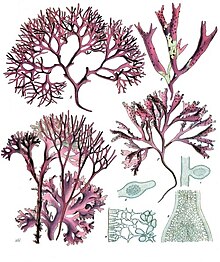Rhodophytes
| Red algae Temporal range: Mesoproterozoic–present |
|
|---|---|
 |
|
| A-D : Chondrus crispus Stackhouse, E-F : J.Ag. |
|
| Scientific classification | |
| Domain: | Eukaryota |
| (unranked): | Diaphoretickes |
| (unranked): | Archaeplastida |
| Division: |
Rhodophyta Wettstein, 1922 Classification is currently disputed. See Taxonomy. |
| Algal group | δ13C range |
|---|---|
| HCO3-using red algae | −22.5‰ to −9.6‰ |
| CO2-using red algae | −34.5‰ to −29.9‰ |
| Brown algae | −20.8‰ to −10.5‰ |
| Green algae | −20.3‰ to −8.8‰ |
Classification is currently disputed. See Taxonomy.
The red algae, or Rhodophyta (/roʊˈdɒfᵻtə/ roh-DOF-fit-tə or /ˌroʊdəˈfaɪtə/ ROH-də-FY-tə; from Ancient Greek: ῥόδον rhodon, "rose" and φυτόν phyton, "plant"), are one of the oldest groups of eukaryotic algae. The Rhodophyta also comprises one of the largest phyla of algae, containing over 7,000 currently recognized species with taxonomic revisions ongoing. The majority of species (6,793) are found in the Florideophyceae (class), and consist of mostly multicellular, marine algae, including many notable seaweeds. Approximately 5% of the red algae occur in freshwater environments with greater concentrations found in the warmer area.
The red algae form a distinct group characterized by having eukaryotic cells without flagella and centrioles, chloroplasts that lack external endoplasmic reticulum and contain unstacked (stoma) thylakoids, and use phycobiliproteins as accessory pigments, which give them their red color. Red algae store sugars as floridean starch, which is a type of starch that consists of highly branched amylopectin without amylose, as food reserves outside their plastids. Most red algae are also multicellular, macroscopic, marine, and reproduce sexually. The red algal life history is typically an alternation of generations that may have three generations rather than two.
...
Wikipedia
